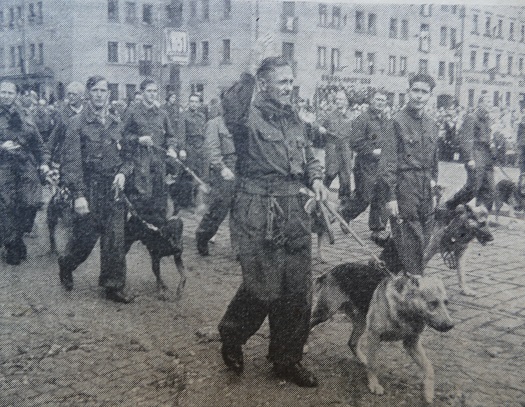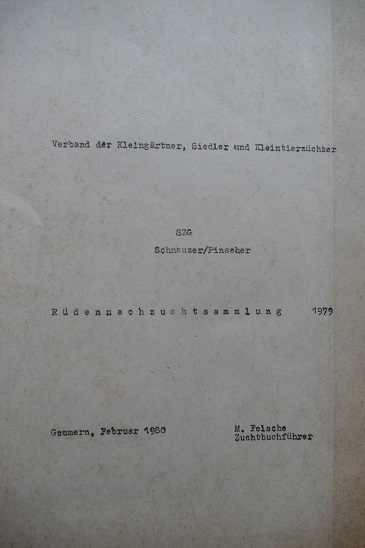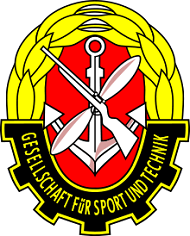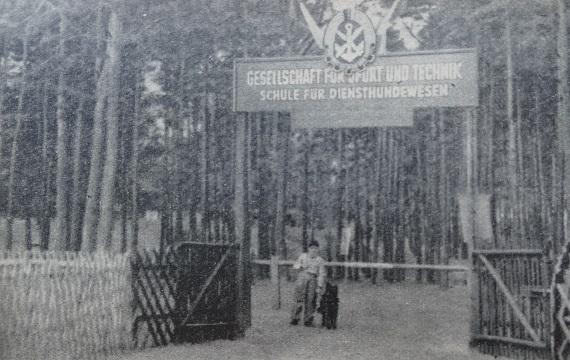
This is page 2 of the article Read Page one
In 1962 the VKSK had about 850,000 members and in 1988 about 1.5 million members. In the VKSK, in the mid-1980s, 68 breeds of dogs were bred. However, it was only the Breeders organized in the VKSK, who did not breed service, utility and hunting dogs. They Dog breeds were approved from 1955-61 by the Gesellschaft für Sport und Technik (GST) and from 1961- in 1990 he was supervised by the Section Service and Utility Dogs (SDG).
The SDG was organized by- satorically independent; but was accountable to the VKSK. The VKSK was still trying to bring the members to the GDR line in 1974, so that they from the West German association thinking (“Der Hund” 2/1974): “The political open-mindedness of our members is becoming more and more noticeable, their distant- the promotion of outdated club and association thinking, the commitment to the policy of our worker- and-peasant-state, and the ever-deepening friendly relations with the Pedigree dog breeders of the socialist neighboring countries.”
There still seemed to be – after all, the GDR had existed for 25 years – a need that To call on members of the VKSK to join the socialist state doctrine. With relationships to pedigree dog breeders in West Germany were hardly possible. Imports of pedigree dogs for sale- improvement of breeding was possible exclusively from the “socialist brother countries”. Moves- permits for the import of pedigree dogs from West Germany were rarely issued. in 1973, a new Framework Breeding Code (RZO) was put into effect by the VKSK. The objective was to centralize and unify the breeding selection and management. At the same time, at least- and maximum limits; e.g.: -18 Months as the minimum age for stud dogs of large breeds, -a maximum of 25 mating acts for one male, -Maximum age for breeding use is 8 years for males and bitches, -Only by a veterinarian or under the supervision of a veterinarian, -Status as a breeder and stud dog owner only if you have been a member of a SZG for at least 1 year, in order to to ensure that the necessary basic knowledge of pedigree dog breeding has been obtained, –
Offspring assessment (NCB), breeding suitability test (ZTP) and licensing are required for all breeds to introduce the VKSK mandatory -Setting the maximum price for the puppy The VKSK set maximum prices for dog puppies in the mid-1980s at 700 marks, on which dog buyers could orient themselves. Considering that at this time the average- gross monthly earnings of 850 marks, the purchase of a pedigree dog was a real luxury. Within the framework of these specifications of the RZO, the SZG of the VKSK were able to define their specifications and as Establish special breeding regulations after approval by the Central Breeding Commission. The editing- However, the implementation of this special breeding regulation by the SZG was very slow. The offspring assessment (NCB) has been introduced for dog breeding.
The results revealed a Analysis of the hereditary value of the father and mother animals. The annual breeding assessments in their Ge- velvety and also the inheritance results of all males were printed annually and all Made available to members.

The breeding of pedigree dogs was carried out only by members of the VKSK who have been a member of the goods, please. All other breeders outside the VKSK were black breeders and made is punishable by law. According to the Exhibition Regulations (1975), the exhibitor had to be a member of the VKSK. The problem for the VKSK was that the acceptance of a companion dog test for the VKSK- The race was hardly possible.
The introduction of the companion dog exam for the VKSK was back- there were hardly enough places and judges to take the exam. In the case of SDG a companion dog exam could be taken in the working dog class, but only when the SDG gave its consent.
The dog sport for VKSK breeds was extremely difficult to realize. The VKSK’s SZG was trimmed in 1975. The new SZG directive of the VKSK presented by the member of the Central Board and chairman of the Central Breeding Commission Dr. Horst Lehmann represents this as follows (The Dog 04/1975): “The special breeding associations are collectives of members within our association, in order to protect the breeding interests through long-term breeding programs, breeding-steering measures etc. to correspond better.
Therefore, they cannot and must not perform a management function, are there are no selectable management and control bodies in the sense of our association.” The VKSK and the district and district lines installed by it took over more and more also in breeding issues, control. After that, the SZG, as a collective of members of the VKSK, has only a non-specific- a written breeding task. Even the administrators of the SZG have since been informed by the Officials of the VKSK were appointed; no one was elected here anymore. An essential component was the offspring assessment (NCB), which began in the 70s should also be carried out for the VKSK breeds.
The breeding wardens were able to did not appear as suitable, refuse. In the 80s, the coverage in the magazine “The Dog” increased to political Topics significantly. There were still solidarity actions for the socialist Movements in Ethiopia and Yemen in order to reduce in these countries “the burdens of colonial oppression to make them disappear through the imperialist yoke” or to make comments on the “heroism soviet people”. But the agitations, especially against West Germany, increased significantly starting. More articles on cynological topics were also published again.
At the end of 1989 and the beginning of 1990, the VKSK was also supported by the democratic movements in the GDR shake. The discussion on the future of the sport of pedigree dogs in the VKSK quickly gained momentum. The redesign of pedigree dog breeding, dog sports and hunting dog breeding should be carried out in a there is an independent central association. First ideas for the foundation of a cynologists’ association in the GDR were on the table.

However, this foundation was not completed. In the middle of 1990, when it was foreseeable that East and West Germany would be reunited, the VDH took over the direction and offered all GDR breed dog clubs, which had been founded in the meantime in large numbers, the Membership. After the reunification, the Extraordinary Association Day of 27 October 1990 in On 31 December 1990, the VKSK organisation was opened in Berlin. Society for Sport and Technology (GST) In November 1955, the hunting, service and utility dog breeds were withdrawn from the VKSK- and the section “Service and Utility Dogs” in the Society for Sport and Technology (GST), a pre-military mass organization of the GDR with the mission of ideological and patriotic education.
The GST was founded on 07.08.1952. An essential task of the GST was to the young members on their military service in the National People’s Army (NVA) prepare. In the GST, the sports of motorsport, shooting sports, off-road sports were, Engaged in sea sports, aviation sports, news sports and model sports. On 14.10.1955 the Council of Ministers of the GDR decided by decree that animal Sports should be included in the GST. So the equestrian sport, racing pigeons became- sports and dog sports –here only the service and utility dogs — now under the The umbrella organization of the GST operated.
Offices and studbook offices, which the special breeding associations of the service- and still independently manage utility dog breeds under the umbrella organization VKSK could, were dissolved by the GST. The documents and documents were confiscated- and the assets of the SZG, which were now members of the GST, were confiscated. The connection to West Germany in the studbook system was completely cut off. It a central studbook was set up starting with the No. 1. The special breeding communities were preserved and got the addition of GST, e.g. “Spezialzuchtgemeinschaft Deutsche Schäferhunde der GST”.
The breeds of dogs that are in the GST were classified as hunting, service and utility dogs. To these breeds included, for example, German Shepherd, Airedale Terrier, Giant Schnauzer, Boxer, Doberman, Dalmatian, Deutsch-Drahthaar and Teckel. The special breeding associations of the GST should be the representation in technical matters be and report to the Section for Dog Sports at the Central Board of the GST. Only the Membership in the GST entitles to participate in shows, exhibitions, licensing etc.. The management of the Special Breeding Association (SZG) of the GST consists of chairman, Deputy, breeding judge supervisor, main breeding supervisor and performance judge supervisor. The offices can be elected with the exception of the judge appointed by the GST opens. When the SZG was set up, the GST filled all management positions “provisionally”, then should the offices of the management be “elected” by the members.
The first occupation by the GST was of course desired and was also confirmed in many subsequent elections. The main task of the SZG was the “steering and management of breeding work”. Also in this task the management of the SZG was intensively supervised by the GST in order to connect the SZG to the GST line bring. The GST took over the magazine “Der Hund” in 1956 and continued it under its direction. The GST set up a central studbook office in 1958, so that it could be used for hunting, service- and there were no more specific SZG breeding books for working dog breeds, and the SZG No longer entitled to issue instructions to the central studbook office of the GST was.
The central studbook office in Halle conducted the statistical registration of erb- biological phenomena and about the breeding value of the parents-animals. She wore the- results of performance tests, received exhibition certificates, suitability for breeding- examinations, offspring assessments, and licensing. This centrally collected data was available for use by the special breeding communities. The GST had become the central breeding- book the following point of View (The Dog, 4/1959): “The studbook offices have always had a key position in dog sports Governmental organizations.
To protect their property and to secure their scope are not uncommon in the past, power struggles have been fought up to the international level. This is from printed materials of previous breeding associations. Many works are known from their own experience- that earlier breed registry offices were preferentially civilised circles- günstigen….Es it has been shown that where the studbooks are still kept in a decentralized there have been lively unauthorized Western connections.
Some of these studbook- posts had the character of branches of West German studbook offices and thus west- german breeding associations. It can be said that the studbook office is the political- has fulfilled the obligation to place the studbooks under the control of our organization. A shortcoming in the studbook office is that the studbook managers are still insufficient to have contributed to the political strengthening of the studbook office.
This is the political Consolidation of the breeding registry for the further development of service and working dogs- of particular importance, because it is the task of the Studbook office, also to evaluate your documents politically.” In particular, matings with “foreign” dogs were strictly observed. Also should only dogs of GST members be used in breeding. Guidelines, breeding- books and breeding regulations should only be transferred centrally from the GST as a printed matter to the- a joint will be made. All other printed materials, e.g. the SZG, were no longer allowed and have been overridden. The SZG retained the task of “the professional guidance of the breeding staff working for their breed- wait, the training of the breeding warden, the breeding funnel candidate and breeding funnel as well as the Junghundbeurteiler”.
But also within the local groups of the SZG –also reason- organization (GO)– should not only be engaged in dog sports or still “worse” is just sitting comfortably together. From “The Dog” 3/1959: “There are still numerous basic organizations that, after the reorganization of the canine- in the GDR, they only changed the name, while according to their character There have been associations in which the petty-bourgeois tendencies of the past have been as are present before. In these basic organizations, the work is carried out by personal Friction and arguments over secondary issues are inhibited. The cause of this is to be sought in the fact that there are usually no discussions in such basic organizations to clarify political problems. It’s all about exhibitions, litter- tragedies and social gatherings and similar problems.
I am asking myself to ver- stand. We are not against socializing. Of course, the dog athletes should be in their They sit comfortably together and involve their wives, who in most of the In some cases, they have taken over the care and feeding of the dog. What we are against but it is necessary to point out that the question of sociability is related to the content of the activity of a It becomes a basic organization. In such basic organizations, our political tasks will be not recognized, one does not know the way to fulfill our tasks, which are assigned to the service and Working dogs are provided. All poli also come from such basic organizations- there are a lot of ambiguities that we are still struggling with.
There you also do not understand, that the tendency to lean towards West German breeding associations or even to- which causes damage to the consolidation and development of our workers’ and peasants’ state. This is where the slogan of apolitical sport has its breeding ground, and thus the hostile striving to prevent our people from actively participating in the construction of socialism, Help is given.”

At that time, in order to devote oneself exclusively to dog sports or dog breeding, one had to only two options. Either you did not join the SZG and organized yourself in private The framework or the entire basic organization was devoted only to the dog system and paid attention to the No further attempts at ideologizing the GST. The GST tried both ways of To prevent withdrawal from GST access. Private dog sportsmen and breeders without a member- schaft had no access to exhibitions, competitions in dog sports or access to the Stud book.
Members in the basic organizations were committed to the “political” To open discussions and monitor this activity. But he had the GST- it is a great difficulty to open up the basis in the basic organizations and to develop the social- to achieve a cunning education of the dog athlete. Many dog sportsmen and breeders, which should now be organized in the GST, were critically minded and not ready to join the GST. For this, the GST writes in “The Dog” 6/1956: “Evil tongues have tried often enough and are still doing so today to dis- criminalize. The bearers of these tongues make a lot of effort to as many people as possible -but especially to discourage young people from entering the GST.
With this you give however, it is very clear that in the GST you are a danger to your own – plans aimed at weakening our policy- see. The remaining Shortcomings and shortcomings in dog sports, especially at the local level, undoubtedly have to do with the fact that a number of formerly active dog sportsmen have contributed to such harmful- he listened to whispers. They have resigned -and have thus been able to to do our workers’ and peasants’ state no greater favour at all. Resignation of the isolation, slackening of training, disorganization of dog sports -that’s exactly what the intention of those people who support our German Democratic Republic in all fields as weak as you want to see.”
The lines show that the GST is very difficult to deal with the criticism of the dog athletes can. Critics are immediately elevated to the level of enemies of the state; the darim with- swinging threat is very clear. Dog athletes in the management of the SZG, who are considered to were classified as critical, were monitored by the Stasi (State Security of the GDR, as it turned out after the reunification, when the files were found in the Stasi archives. Justification of the Stasi measures for the creation of the Stasi file for some dog athletes was:
“Reasons for creating-The persons to be registered in the preliminary file are negative forces, which are trying to hamper in the service dog system of the GDR on to influence socialist development.” These dog athletes have now been intensively monitored and treated with informal staff- spying. Nevertheless, the criticism of the organization, communication and cooperation of the Don’t stop dog sports. The GST finds it difficult to integrate dog sports into its organization. The- resigned members of the GST often did not pay the membership fees. Members of the Special breeding communities did not want to join the GST despite numerous calls in the magazine “The Dog”.
Many dog sportsmen interfered with the military-poli- and centralization efforts of the GST. Numerous political contributions in the GST magazine “Der Hund” with calls for the GDR elections or for participation in military parades on May 1 had little to do with dog sports and breeding. The GST was trying to ideologize its members and was particularly concerned with the youth- apart from the GDR. Under titles like “Hasso also wants to protect our construction” in particular, the use of service dogs in the military field and for the internal- the German border guard is ideologically instrumentalized. This objective of the GST “Education man’s” was openly proclaimed (The Dog 8/1957): “The unfolding of a bold, ideological offensive against all bourgeois, pazi- against the fistic influences and against the mere sportsmanship in the organization; the increased Propagating the military ideology of the working class among the working people, and above all our youth; their education as friends of our National People’s Army and their ready- to strengthen their ranks; close connection of patriotic education with the Training.”
The political contributions to this often had a rather low level (Der Hund 8/1957): “Our dogs are not there for the American nuclear bomb camps in West Germany guard. They guard the property and life of the working people in our republic; they guard bridges and railway facilities from attacks by imperialist agents.” On the other hand, the apolitical professional contributions to dog sports and breeding in the GST were- Magazine “The Dog” often at a very high level. The political contributions that had little to do with dog sports or breeding, but took up more and more space in the The magazine “The Dog”. The GST is very clear in the dog 4/1959 with regard to the orientation of the dog system –in particular the service and utility dog industry–: “What matters in our organization is ideological clarity about the principles of To create dog science in the GDR. It must be pointed out that the management of service- the task of our armed forces is to support our armed forces in every possible way. It must be in the future, a closer connection with the VP (note.: Volkspolizei) resp. VP limit (Note.: Police for the inner German border). extraction young comrades for the NVA (note.: National People’s Army of the GDR) but also by- trained service dog handlers, especially for the VP limit, is a constant task. Class-conscious older dog handlers are to be recruited as volunteer VP helpers.
In addition is there a willingness among dog handlers to awaken their dogs in support of the safe- the organs of our Republic.” In addition to the ideological education of the dog athletes, the dog training for the GST also a purpose-oriented orientation, which contributes to the pre-military orientation of the GST the use of trained service dogs in the police, border protection and in the military.
Continue Reading German Shepherd Dogs DDR History Page 3
Source: wallenfels-pinscher
